I bought this Japanese newspaper on eBay a couple of years ago. I can't read any Japanese, but the seller included this description:
The main headline is:
"Ceremonial entry into Hong Kong by Imperial Japanese Army and Navy "
Some articles and pictures:
- Japan flag stands at the Victoria Park, Hong Kong
- Commander Sakai and Japan troops parade through Hong Kong
- Celebration for occuping Hong Kong held
- Occupation of all islands of Hong Kong is complete
- Japan troops bombs Manila
- Map: around Manila, the Philippines
- Report from Manila: Manila fallen soon
- Picture: Hong Kong residents come out of Air-raid Shelter
- Picture: British soldiers disarmed in Hong Kong
- Picture: Detained British and American children with smiles for Japanese victory in Hong Kong
- Analysis: How to fight against British and American weapons
- Picture: British HMS Unity (N66)
- Unque commercial ads
- etc,
Here are complete scans of the newspaper pages (click any thumbnail for a larger view). Thanks to Paul Wan and his friend, we now have translations of the articles that mention Hong Kong. Paul writes:
You and I have a New Year gift from my friend in Vancouver, who translated the gist of the newspaper for Gwulo fans. He said that the newspaper is in classic (old) Japanese. You may share the content in Gwulo.
Thanks again to Paul and his friend. I'll paste in the translations below.
Page 1 – six headlines/columns mention about Hong Kong
- Headline: 莊嚴!香港入城式 (Solemn! Hong Kong City Entering Ceremony)
In the morning of the 28th the weather was good. At the hill top in Hong Kong Island: the Victoria Peak, the Japanese flag was flying. It was a good day for holding the city entering ceremony. Sakai, the Supreme Commanding Officer in HK at 2.00 pm departed for the ceremony. He inspected the parade at the Boundary Street etc. Then from Kowloon he traveled to Hong Kong Island. At So Kwan Po he greeted the platoons from the army and the navy. Later together with high ranking officers, he inspected the parading army on horse in Central. The city entering ceremony was ended at 4.10 pm, then in a car Sakai was driven to the Governor House located at the middle of a hill. The air force and the navy also had contributed performance for the ceremony. - Headline: 次いて占領祝賀式 (The Occupation Cerebration Ceremony that Followed)
After the city entering ceremony was over, senior officers at the parade arrived at the Governor House at 4.30 pm to take a break. Then at the open space outside the Governor House a ceremony was held. The supreme army commander Sakai made a speech and the ceremony was ended by photo taking. Inside the building there were singing and dancing and toasting, the event was ended at 5.30 pm. - Headline: 征戰日記 (War Campaign Diary)
In the occupation of Hong Kong, the army and the navy disarmed the enemy on the 26th afternoon and occupied the whole island. On the 27th the Navy entered the harbor. On the 28th the city entering ceremony was held. . . (This column continues to talk about other war fronts at locations outside Hong Kong) - Headline: 香港の在米資產凍結 (Hong Kong’s Assets in the US Frozen)
(News released from Buenos Aires) The United States Finance Minister announced the frozen of HK assets in the US when Hong Kong came under the Japanese occupation. - Headline:香港全島占領完了(Hong Kong Whole Island Occupation Completed)
Hong Kong Island had been completely occupied. The Imperial Army and Navy charged with the duty to attack Hong Kong had disarmed the enemy. They were disarmed on the 26th at 6.00 pm and the whole island was occupied. - Headline:武熏力輝く海軍部隊 堂タと香港入港 (The Navy with a Commanding Presence, Entering Hong Kong Harbor with anImpressive Bearing)
Before the city entering ceremony, the Navy in Hong Kong made a splendid appearance in the Hong Kong’s waters on the 27th at 10.00 am. At 3.00 pm on the same day, the Navy senior officials visited the Supreme Commander Sakai. They shook hand to express thanks for breaking the British’s 100-year dream of imperial invasion in S.E. Asia. The navy had been on alert to the possible escape of the British gun boats and torpedo boats etc. They shot at and sank torpedo boats that tried to escape at high speed. They cut the cable line under the sea, stopping Hong Kong’s connection with the outside and thus isolated Hong Kong Island. They attacked the Stone Cutter Island and occupied the war supply depot, and subsequently the army could land at the Kowloon Peninsula. On 26th when entering Hong Kong the navy met not even one enemy boat. In total they captured over 200 boats of various descriptions.
Page 2 - one headline is related to Hong Kong
-
Headline: 曉に歡喜の訪れ 勝利告ぐる軍使 (A Happy Visit at Dawn, Army Visitors that Announced the Victory)
(It is an article written by Yano, the chief Japanese Consular General in Hong Kong and he sent it to the Asahi Newspaper for publishing. The title’s article was “Eighteen Days in a Surrounded City”)
On December 12th the Chief Consular General of Japan in Hong Kong together with other Japanese (mostly heads of big Japanese organizations in Hong Kong) visited the Japanese prisoners locked up by the British in the Stanley Prison to give them courage and spiritual support. On their return trip back to the residence of the Consular General they encounter shelling and other dangers. When they arrived at the Consular residence and stayed. On the 25th at 4.45 pm they knew that the British had surrendered and they immediately disarmed the British soldiers guarding the Consular residence. On 26th December at 4.40 am they were visited by three officials from the Japanese Army to inform them about the defeat of the British forces in Hong Kong.
Page 3 - two headlines are related to Hong Kong
-
Headline: 堵列の將士淚あり 今ぞひれ伏す香港 (The Soldiers and Officers in the Lining-up Were With Tears, Now Hong Kong groveled at my feet)
The city entering ceremony held on the 28th December was started at 3.00 pm. Along Queen’s Road; there was a two-mile long army and navy parade. It was followed by a victory celebration ceremony at the Hong Kong Governor’s House. The business center near the Hong Kong and Shanghai Bank was flying a Japanese flag. There were those Japanese who had been locked up for 18 days and now released to freedom from the hands of the Japanese Imperial army. There planes flew pass from the west. At the So Kwan Po, the military band played music. The parading soldiers had tears on the face and were gratifying their fallen comrades.
-
Headline: 九龍で散華 台灣日タ 記者 (A Taiwan Reporter Died in Kowloon)
A Japanese army reporter from Taiwan was killed by shrapnel that hit at his heart on 23rd shortly after 11.00 am while he was staying with a marine detachment.
Page 4 - no news about Hong Kong
There is more background information about this Japanese newspaper company available on Wikipedia.
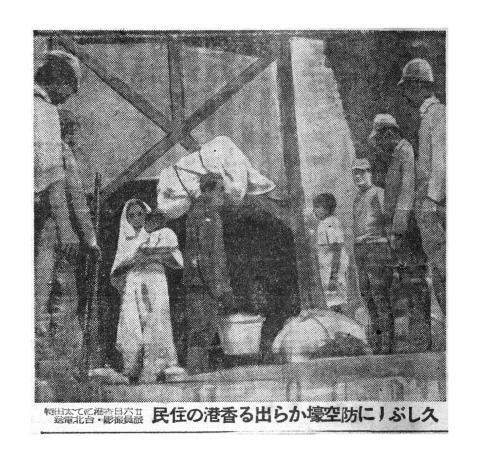
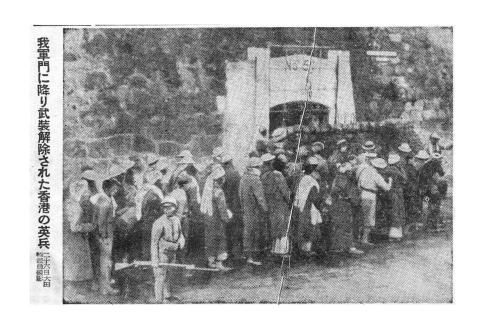
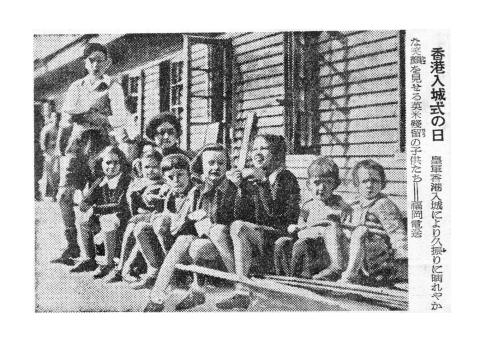

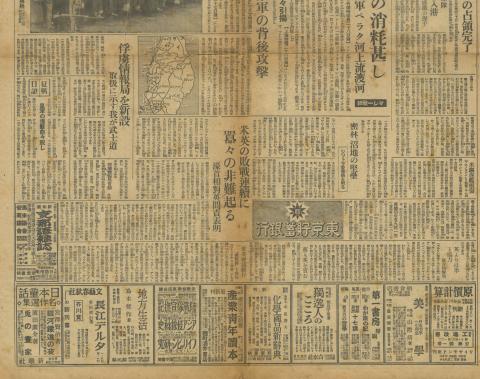
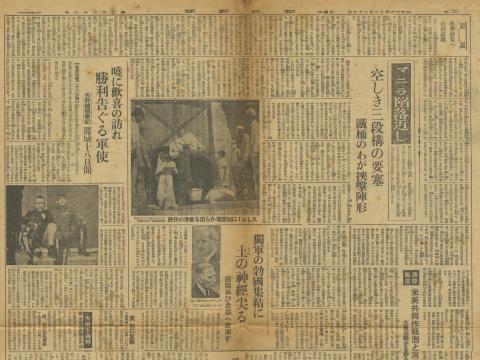

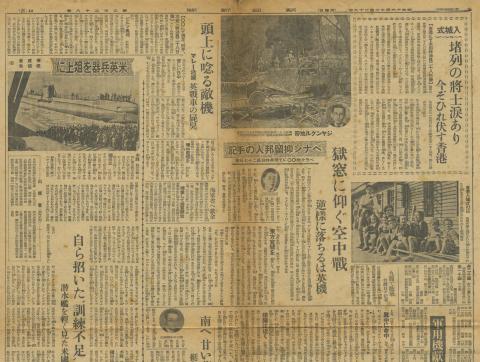
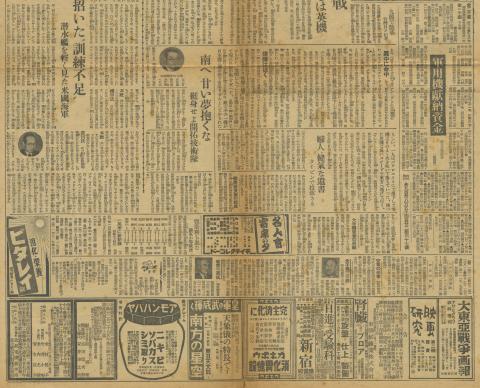
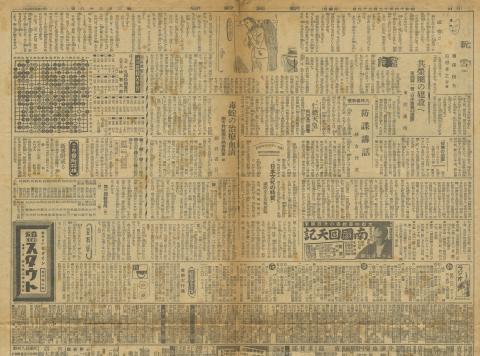

Comments
Translations of top half of page 1
Thanks to Jeremy for sending in this translation:
well no time to go thru the whole paper but just to give you a taster...
looking at the first page the masthead top right is of the asahi shimbun, the newspaper name. now the asahi is a highly respectable liberal (for japan) paper but at that time of course it would just be printing propaganda. the date is dec 29th 1941. many of the characters in the headlines (associated with war and imperial glory) are no longer used in modern japanese (big clear out after war in line with general purging by macarthur) so this is pretty hard to read. even my japanese wife can't read it! but this is the gist (reading from right to left and from top to bottom):
Also thanks to Kin via Guy for translating the start of the introductory paragraph:
"Clear morning, on top of the Victoria peak, where it most defensible area, Japanese flag is flapping by breeze which make the perfect day for entry the city of Hong Kong.
At 2pm, Chief of offence officer Mr Sakai left Kowloon commanding office, riding the horse on Nathan road……"
It's now clear that the seller's original translation, "Japan flag stands at the Victoria Park" at the top of the page should have referred to "Victoria Peak".
If you can add any more translations, please leave a comment below. (I'm specially curious to know more about the photo of the children on page 3).
Regards, David
Additional translation
I just received an email from Paul Wan: "You and I have a New Year gift from my friend in Vancouver, who translated the gist of the newspaper for Gwulo fans. He said that the newspaper is in classic (old) Japanese. You may share the content in Gwulo."
Many thanks to Paul and his friend. Here is the translation:
Asahi Newspaper dated 29th December 1941 - a translation
Page one – six headlines/columns mention about Hong Kong
Headline: 莊嚴!香港入城式 (Solemn! Hong Kong City Entering Ceremony)
In the morning of the 28th the weather was good. At the hill top in Hong Kong Island: the Victoria Peak, the Japanese flag was flying. It was a good day for holding the city entering ceremony. Sakai, the Supreme Commanding Officer in HK at 2.00 pm departed for the ceremony. He inspected the parade at the Boundary Street etc. Then from Kowloon he traveled to Hong Kong Island. At So Kwan Po he greeted the platoons from the army and the navy. Later together with high ranking officers, he inspected the parading army on horse in Central. The city entering ceremony was ended at 4.10 pm, then in a car Sakai was driven to the Governor House located at the middle of a hill. The air force and the navy also had contributed performance for the ceremony.
Headline: 次いて占領祝賀式 (The Occupation Cerebration Ceremony that Followed)
After the city entering ceremony was over, senior officers at the parade arrived at the Governor House at 4.30 pm to take a break. Then at the open space outside the Governor House a ceremony was held. The supreme army commander Sakai made a speech and the ceremony was ended by photo taking. Inside the building there were singing and dancing and toasting, the event was ended at 5.30 pm.
Headline: 征戰日記 (War Campaign Diary)
In the occupation of Hong Kong, the army and the navy disarmed the enemy on the 26th afternoon and occupied the whole island. On the 27th the Navy entered the harbor. On the 28th the city entering ceremony was held. . . (This column continues to talk about other war fronts at locations outside Hong Kong)
Headline: 香港の在米資產凍結 (Hong Kong’s Assets in the US Frozen)
(News released from Buenos Aires) The United States Finance Minister announced the frozen of HK assets in the US when Hong Kong came under the Japanese occupation.
Headline:香港全島占領完了(Hong Kong Whole Island Occupation Completed)
Hong Kong Island had been completely occupied. The Imperial Army and Navy charged with the duty to attack Hong Kong had disarmed the enemy. They were disarmed on the 26th at 6.00 pm and the whole island was occupied.
Headline:武熏力輝く海軍部隊 堂タと香港入港 (The Navy with a Commanding Presence, Entering Hong Kong Harbor with an Impressive Bearing)
Before the city entering ceremony, the Navy in Hong Kong made a splendid appearance in the Hong Kong’s waters on the 27th at 10.00 am. At 3.00 pm on the same day, the Navy senior officials visited the Supreme Commander Sakai. They shook hand to express thanks for breaking the British’s 100-year dream of imperial invasion in S.E. Asia. The navy had been on alert to the possible escape of the British gun boats and torpedo boats etc. They shot at and sank torpedo boats that tried to escape at high speed. They cut the cable line under the sea, stopping Hong Kong’s connection with the outside and thus isolated Hong Kong Island. They attacked the Stone Cutter Island and occupied the war supply depot, and subsequently the army could land at the Kowloon Peninsula. On 26th when entering Hong Kong the navy met not even one enemy boat. In total they captured over 200 boats of various descriptions.
Page 2 – one headline is related to Hong Kong
Headline: 曉に歡喜の訪れ 勝利告ぐる軍使 (A Happy Visit at Dawn, Army Visitors that Announced the Victory)
(It is an article written by Yano, the chief Japanese Consular General in Hong Kong and he sent it to the Asahi Newspaper for publishing. The title’s article was “Eighteen Days in a Surrounded City”)
On December 12th the Chief Consular General of Japan in Hong Kong together with other Japanese (mostly heads of big Japanese organizations in Hong Kong) visited the Japanese prisoners locked up by the British in the Stanley Prison to give them courage and spiritual support. On their return trip back to the residence of the Consular General they encounter shelling and other dangers. When they arrived at the Consular residence and stayed. On the 25th at 4.45 pm they knew that the British had surrendered and they immediately disarmed the British soldiers guarding the Consular residence. On 26th December at 4.40 am they were visited by three officials from the Japanese Army to inform them about the defeat of the British forces in Hong Kong.
Page 3 – two headlines are related to Hong Kong
Headline: 堵列の將士淚あり 今ぞひれ伏す香港 (The Soldiers and Officers in the Lining-up Were With Tears, Now Hong Kong groveled at my feet)
The city entering ceremony held on the 28th December was started at 3.00 pm. Along Queen’s Road; there was a two-mile long army and navy parade. It was followed by a victory celebration ceremony at the Hong Kong Governor’s House. The business center near the Hong Kong and Shanghai Bank was flying a Japanese flag. There were those Japanese who had been locked up for 18 days and now released to freedom from the hands of the Japanese Imperial army. There planes flew pass from the west. At the So Kwan Po, the military band played music. The parading soldiers had tears on the face and were gratifying their fallen comrades.
2. Headline: 九龍で散華 台灣日タ 記者 (A Taiwan Reporter Died in Kowloon)
A Japanese army reporter from Taiwan was killed by shrapnel that hit at his heart on 23rd shortly after 11.00 am while he was staying with a marine detachment.
Page 4- no news about Hong Kong